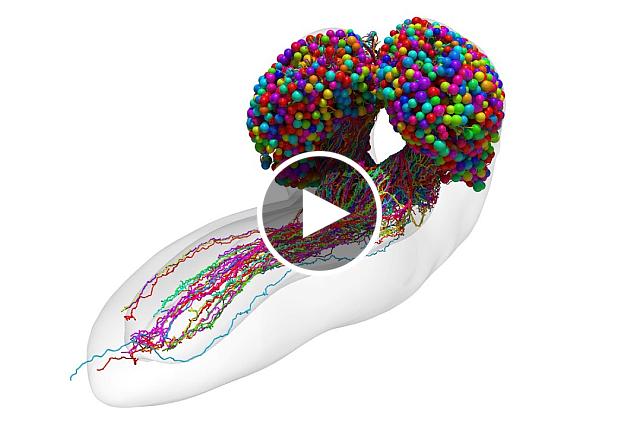You are here
March 28, 2023
Complete wiring map of the insect brain
At a Glance
- Researchers mapped out all the nerve connections in a larval fruit fly brain.
- This first complete wiring map of an insect brain could aid future brain research and inspire new machine learning architectures.
The brain contains vast networks of interconnected neurons. Understanding how the brain works requires knowing how the various neurons connect to each other. A complete map of all the connections in an entire brain—called a connectome—has only been worked out for three organisms so far. These organisms—a roundworm, a larval sea squirt, and a larval marine worm—each have several hundred brain neurons at most. Mapping larger and more complex brains remains a technical challenge and has been done only for parts of the brain.
An international research team set out to map the entire brain of a small insect. They chose the larva of the fruit fly Drosophila melanogaster. Fruit flies show a rich mix of behaviors, yet their brains are small enough to map out within a practical time frame. The fruit fly connectome, which took more than five years to map out, appeared in Science on March 10, 2023.
The complete fruit fly connectome consists of more than 3,000 neurons and more than half a million synapses—the points of connection between different neurons. The researchers classified neurons based on the various ways they connected to each other. Using this approach, they identified 93 distinct neuron types. There were three general categories of neurons: input neurons, which bring information from the senses into the brain; output neurons, which transmit signals out of the brain; and interneurons, which connect with other neurons within the brain.
The team traced the pathways from sensory input neurons to output neurons. They found that neural circuits resembled those found in state-of-the-art computer machine learning. For example, a signal could travel from a given input to a given output through several routes with varying numbers of steps. These parallel routes were highly interconnected, forming what is called a distributed processing network. Many neurons also received feedback from their downstream partner neurons. This feature, called recurrent architecture, was especially common in neurons associated with the brain’s learning center.
Most of the brain’s hub neurons—those with the most connections—were connected to the learning center. Hubs were also more likely than other neurons to form connections to the opposite brain hemisphere. This suggests the importance of communication between hemispheres.
The team looked at interactions between the brain and the ventral nerve cord—the insect equivalent of the spinal cord. Brain output neurons tended to connect to nerve cord neurons just upstream of neurons that control movement. These connections could play a role in switching between different types of movement. Some output neurons connected to nerve cord neurons downstream of sensory neurons. These connections may affect how the brain perceives sensory input.
Although the details of brain organization differ among animals, past studies have shown that many circuits are similar. The fruit fly connectome provides a starting point for studying the roles of specific neurons and circuits. The techniques developed for this study could be applied to studying the connectomes of other species. Comparisons between connectomes could reveal fundamental principles of brain architecture. They might also inspire new artificial neural networks.
“If we want to understand who we are and how we think, part of that is understanding the mechanism of thought,” co-lead author Dr. Joshua Vogelstein of Johns Hopkins University says. “And the key to that is knowing how neurons connect with each other.”
—by Brian Doctrow, Ph.D.
Related Links
- Imaging Technique Shows Alzheimer’s Impact on Brain Connections
- Gut Communicates Directly with Brain
- An Expanded Map of the Human Brain
- Mapping Brain Circuits Involved in Attention
- Brain Mapping of Language Impairments
- An Atlas of the Developing Human Brain
- The BRAIN Initiative
References: The connectome of an insect brain. Winding M, Pedigo BD, Barnes CL, Patsolic HG, Park Y, Kazimiers T, Fushiki A, Andrade IV, Khandelwal A, Valdes-Aleman J, Li F, Randel N, Barsotti E, Correia A, Fetter RD, Hartenstein V, Priebe CE, Vogelstein JT, Cardona A, Zlatic M. Science. 2023 Mar 10;379(6636):eadd9330. doi: 10.1126/science.add9330. Epub 2023 Mar 10. PMID: 36893230.
Funding: NIH’s National Institute of Mental Health (NIMH), National Institute of Neurological Disorders and Stroke (NINDS), and Brain Research Through Advancing Innovative Neurotechnologies® (BRAIN) Initiative; National Science Foundation; Howard Hughes Medical Institute; Defense Advanced Research Projects Agency; Air Force Research Laboratory; Wellcome Trust; U.K. Research and Innovation; European Research Council.

